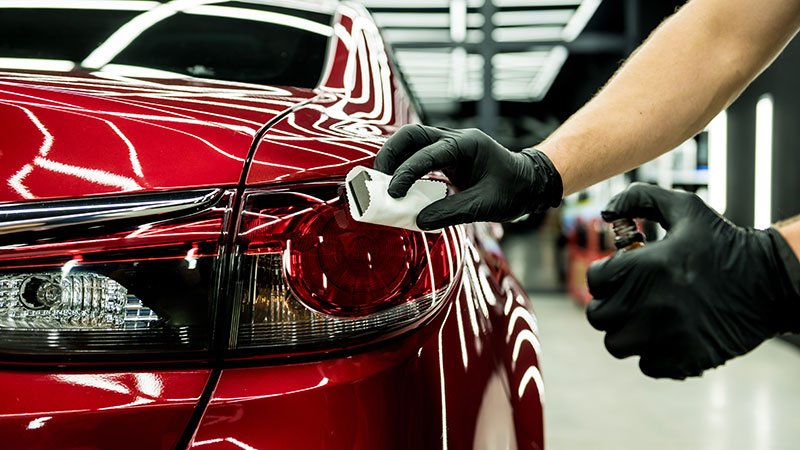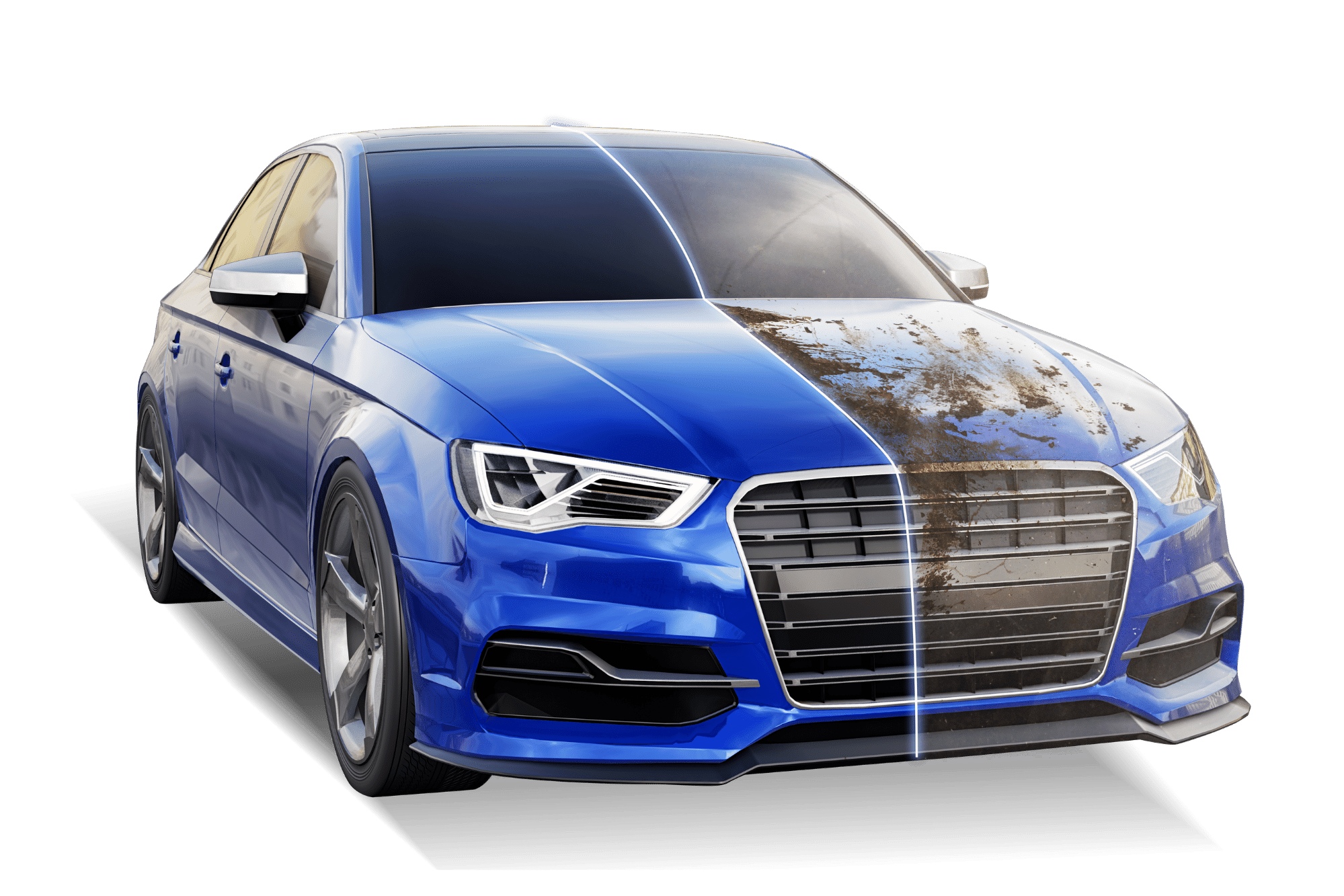Why pairing detailing services with Ceramic Coating Newark delivers better results
Discovering the Scientific Research Behind Car Ceramic Coating and Its Protective Characteristics
The science of car ceramic coating offers a fascinating research study in sophisticated vehicle defense. Composed largely of silicon dioxide and polymers, these coatings develop a robust bond with vehicle paint. This interaction boosts resilience against environmental threats while using hydrophobic advantages. The details of just how these coatings job and their lasting advantages continue to be less understood. Ceramic Coating Newark. Unboxing these details discloses why ceramic coverings are coming to be a preferred selection for automobile care
What Is Ceramic Coating?
Ceramic coating is a liquid polymer that chemically bonds to the surface of a lorry's paint. This innovative protective layer enhances resilience and uses remarkable resistance to environmental elements. Unlike traditional wax or sealants, which offer temporary defense, ceramic finishes produce a lasting guard that can endure harsh problems such as UV rays, acidic impurities, and severe weather. When applied appropriately, the coating develops a hydrophobic surface, causing water to grain and slide off, which aids in preserving the car's cleanliness. Additionally, it supplies improved gloss and depth to the paint, making the lorry show up more sleek and dynamic. The application process typically involves thorough surface area prep work, including cleansing and sprucing up, to ensure peak bonding. Consequently, ceramic finishings are becoming significantly preferred amongst car lovers and those looking for to safeguard their financial investments, guaranteeing to preserve the lorry's aesthetic charm while reducing the frequency of upkeep.
The Structure of Ceramic Coatings
The detailed formulation of ceramic layers largely contains silicon dioxide (SiO2), which is stemmed from natural resources like quartz and sand. This vital element supplies the foundation for the coating's sturdiness and safety top qualities. Along with SiO2, ceramic finishes often include different polymers and ingredients that boost bond, flexibility, and resistance to ecological elements. These compounds function synergistically to produce a durable obstacle versus impurities such as dust, chemicals, and UV rays.Furthermore, some formulations incorporate titanium dioxide (TiO2) or various other nanomaterials, which can boost the coating's hydrophobic residential properties, causing better water repellency. The precise composition can vary considerably amongst producers, affecting efficiency and longevity. Inevitably, the mix of these aspects culminates in a protective layer that not just improves the visual allure of lorries however also serves to extend their lifespan by shielding the surface from possible damages.
Just How Ceramic Coatings Work
Recognizing just how ceramic layers function includes discovering their chemical make-up, which adds to their protective qualities. The application procedure is important for achieving optimal outcomes, while longevity and longevity factors determine the coating's performance in time. Together, these aspects highlight the advantages and performance of ceramic finishes for vehicle protection.
Chemical Make-up Explained
While several car owners look for durable protection for their vehicles, the chemical make-up of ceramic finishes plays an essential role in their effectiveness. These coverings primarily include silicon dioxide (SiO2), which is obtained from all-natural minerals. This compound forms a strong bond with the vehicle's paint, creating a durable, safety layer. Additionally, several ceramic coverings include titanium dioxide (TiO2), boosting their hydrophobic homes and resistance to UV rays. The visibility of polysiloxanes can further improve adaptability and sturdiness. With each other, these aspects add to the coating's capability to drive away water, dirt, and contaminants, while also giving a high-gloss coating. Recognizing this chemical foundation aids car proprietors value the durable protection used by ceramic coatings.
Application Process Summary
Using ceramic coatings involves a meticulous procedure that ensures ideal bonding and protection for the car's surface area. Detailed cleansing and decontamination of the car's exterior are done to remove dirt, gunk, and previous waxes. This step confirms that the surface is devoid of pollutants that could hinder adhesion. Following this, the paint is typically brightened to improve clearness and remove any kind of imperfections. When prepared, the ceramic coating is applied in tiny sections making use of an applicator pad, allowing for consistent insurance coverage. The coating is after that entrusted to heal, forming a strong chemical bond with the surface. Proper curing times and problems are critical, as they confirm the coating accomplishes its maximum efficiency and protective qualities.
Long Life and Longevity Elements
Ceramic coverings are made to offer durable protection with their innovative chemical structure, which produces a robust barrier against environmental contaminants. The longevity of these finishes is affected by elements such as the density of the application, the quality of the product, and the problems under which the vehicle is subjected. High-grade ceramic layers can last a number of years, resisting scratches, UV rays, and chemical spots. Proper upkeep, consisting of routine washing and regular reapplication, can further boost long life. In addition, environmental factors like environment and direct exposure to pollutants can affect the life expectancy of the coating. Generally, when applied and preserved appropriately, ceramic coverings use phenomenal sturdiness, making them a prominent choice for car lovers looking for to preserve their site link automobile's appearance.
Hydrophobic Properties and Water Repellency
Hydrophobic homes are a characteristic of quality car ceramic finishes, significantly boosting the lorry's surface performance. These layers create check my reference a molecular bond with the car's paint, leading to a surface area that repels water effectively. When water enters into call with a ceramic-coated surface area, it beads up and rolls off, reducing the amount of fluid that stays on the paint. This habits not just adds to a visually pleasing appearance yet additionally decreases the build-up of impurities such as dust, crud, and roadway salts.The boosted water repellency leads to easier cleaning and maintenance, as less effort is required to remove unwanted substances. On top of that, the hydrophobic nature of ceramic finishes assists in avoiding water places, which can mar the surface of uncoated surface areas. Generally, the incorporation of hydrophobic homes in ceramic finishings plays a vital duty in preserving the vehicle's excellent appearance while streamlining maintenance.
Security Versus Scratches and UV Damage
Car ceramic layers provide significant protection against scrapes and UV damage. The scrape resistance system creates a resilient layer that soaks up influences, while the UV securing advantages aid maintain the car's paint integrity in time. With each other, these functions contribute to a longer-lasting and aesthetically attractive finish.
Damage Resistance System
Utilizing innovative modern technology, ceramic coverings offer a durable shield versus scratches and UV damage, boosting the durability and appearance of lorry surfaces. The scrape resistance system of these coatings is credited to their special molecular structure, which creates a resilient bond with the lorry's paint. This bond produces a hard, safety layer that can take in impacts and withstand abrasions. In addition, the smooth surface of the coating minimizes friction, making it hard for contaminants to stick and trigger scratches. The chemical structure of ceramic coatings typically includes nanoparticles that enhance the protective layer, additional enhancing its durability. Automobiles treated with ceramic finishings display substantially boosted scrape resistance contrasted to typical wax or sealers, making certain an excellent surface over time.
UV Shielding Perks
The protective top qualities of ceramic finishes extend beyond scratch resistance to consist of significant UV shielding benefits. These layers produce a robust barrier that mirrors unsafe ultraviolet rays, protecting the vehicle's paint and underlying materials. Long term exposure to UV see this radiation can cause fading, oxidation, and deterioration of the paint finish. By integrating ceramic coatings, automobile owners can properly reduce these threats, maintaining the aesthetic allure and stability of their cars and trucks. Furthermore, the UV blocking residential or commercial properties add to boosted longevity, reducing the regularity of repainting and maintenance. Eventually, the integration of ceramic layers uses a detailed remedy for securing cars from the destructive impacts of sunlight exposure, making certain a sustained, dynamic look in time.
The Long life and Maintenance of Ceramic Coatings

Frequently Asked Concerns
Can Ceramic Coating Be Applied to Any Type Of Kind of Car?
Ceramic coating can be put on numerous sorts of automobiles, consisting of vehicles, trucks, and motorbikes. However, surface preparation and compatibility with particular materials are necessary for excellent attachment and effectiveness of the coating.
Exactly How Much Does Ceramic Coating Normally Expense?
Ceramic coating normally costs between $500 and $2,000, depending on factors such as car dimension, coating quality, and specialist application. The financial investment can supply long-lasting protection and enhance the car's look in time.

Is Professional Application Needed for Finest Results?
The necessity of professional application frequently depends on wanted outcomes. Experts generally assure correct surface area preparation and application techniques, bring about excellent bonding and durability of the coating, which may be challenging for unskilled individuals to achieve.
Can Porcelain Coatings Be Eliminated or Repaired?
Ceramic coatings can be removed or repaired, though the process may require details solvents or methods - Ceramic Coating Newark. Appropriate elimination is vital to stay clear of damage to the underlying surface area, stressing the relevance of professional assistance for suitable results
Just How Does Ceramic Coating Contrast to Typical Wax?
The contrast in between ceramic coating and conventional wax reveals that ceramic coatings offer exceptional resilience, improved defense versus ecological pollutants, and longer-lasting sparkle, while wax calls for more constant application and offers less general resistance to damage.